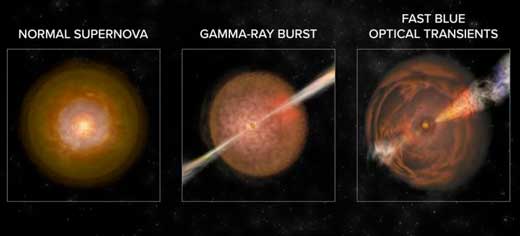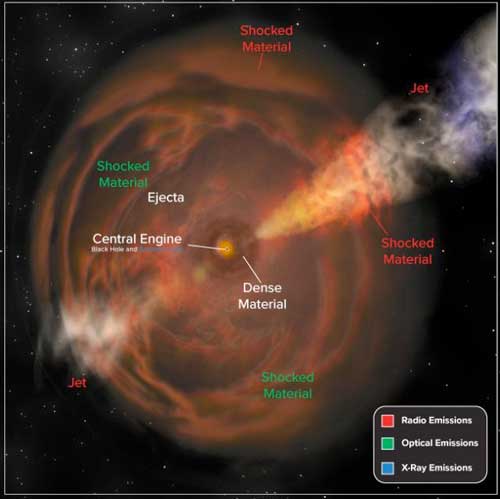| May 27, 2020 |
Astrophysicists capture new class of transient objects
|
|
(Nanowerk News) Move aside, AT2018COW. There is a new astronomical transient in the universe, and it is faster, heavier and brighter at radio wavelengths than its mysterious predecessors.
|
|
After astronomers visually spotted a bright burst in a tiny galaxy 500 million lightyears away from Earth in 2016, a Northwestern University-led team has determined that the anomaly is the third fast blue optical transient (FBOT) ever captured in radio- and X-ray wavelengths.
|
|
A highly luminous family of cosmic explosions, FBOTs have a track record for surprising astronomers with their fast, energetic, powerful bursts of energy. As their name implies, transients fade almost as quickly as they appear. Perhaps the most famous FBOT is AT2018COW ("The Cow") -- a rare event that appeared to be the birth of a black hole or a neutron star. But the newly identified FBOT, called CRTS-CSS161010 J045834-081803 or CSS161010 for short, has vastly overshadowed the Cow with the sheer speeds and heaviness of its material outflows.
|
|
CSS161010, in fact, has produced some of the fastest outflows in nature, launching gas and particles at more than 55% the speed of light. Its mind-boggling fast outflows also are the heaviest documented for its class.
|
 |
| Artistic illustration depicting a side-by-side comparison of ways to produce super fast outflows in nature. (Image: Bill Saxton, NRAO/AUI/NSF)
|
|
"This was unexpected," said Northwestern's Deanne Coppejans, who is first author of the study. "We know of energetic explosions that can eject material at almost the speed of light, specifically gamma ray bursts, but they only launch a small amount of mass -- about 1 millionth the mass of the sun. CSS161010 launched 1 to 10 percent the mass of the sun at more than half the speed of light -- evidence that this is a new class of transient."
|
|
"We thought we knew what produced the fastest outflows in nature," said Northwestern's Raffaella Margutti, a senior author of the study. "We thought there were only two ways to produce them -- by collapsing a massive star with a gamma ray burst or two neutron stars merging. We thought that was it. With this study, we are introducing a third way to launch these outflows. There is a new beast out there, and it's able to produce the same energetic phenomenon."
|
|
The research will be published in the Astrophysical Journal ("A Mildly Relativistic Outflow from the Energetic, Fast-rising Blue Optical Transient CSS161010 in a Dwarf Galaxy").
|
|
Margutti is an assistant professor of physics and astronomy in Northwestern's Weinberg College of Arts and Sciences and a member of CIERA (Center for Interdisciplinary Exploration and Research in Astrophysics). Coppejans is a postdoctoral associate in CIERA and part of Margutti's transients research group.
|
What's an FBOT?
|
|
FBOTs (pronounced F-bot) are a type of cosmic explosion initially detected in the optical wavelength. So hot that they glow blue, FBOTs reach peak brightness within a matter of days and then quickly fade -- much faster than standard supernovae rise and decay. Although astronomers recognized FBOTs as their own class in 2014, they assume these curious anomalies have been dotting our nightsky for much longer.
|
|
"These have probably been inside our archives for a long time, but we didn't recognize them as anything different," Margutti said. "We saw glitches in other galaxies that we couldn't explain. But we couldn't get information outside the optical wavelength, so we couldn't examine them further. We would just call them 'weird supernovae.'"
|
 |
| An artistic illustration of a fast blue optical transient (FBOT). (Image: Bill Saxton, NRAO/AUI/NSF)
|
|
Margutti's team combines multiple observatories to gather more insight into these mysterious explosions. In 2016, researchers at the Catalina Real-time Transient Survey and the All Sky Automated Supernova Survey (ASAS-SN) independently spotted CSS161010 with optical wavelengths. An ASAS-SN team then approached Margutti and Coppejans to take a closer look using their expertise in X-ray and radio waves.
|
|
Because Northwestern has remote access to the Keck Observatory, which has the largest optical and infrared telescopes in the U.S., they were able to observe the phenomenon directly. (Northwestern is one of only four institutions in the U.S. to have such access.)
|
|
"The optical wavelengths can tell us about the particles moving slowly in an explosion. But 'moving slowly' is still 10,000 kilometers per second," Margutti said. "If you want to see the faster particles, then you have to use X-rays and radio waves. Then you can put them all together to see a more complete picture."
|
|
Although the astrophysicists concluded that CSS161010 is definitely an FBOT, they may never know its true, underlying nature. It simply flared up and then faded too quickly. Still, they have a guess.
|
|
"We think it's a very rare type of stellar explosion," Coppejans said. "Although it is less likely, CSS161010 could instead be a star being eaten by a medium-sized black hole."
|
|
"The Cow and CSS161010 were very different in how fast they were able to speed up these outflows," Margutti said. "But they do share one thing -- this presence of a black hole or neutron star inside. That's the key ingredient."
|
CSS161010's strange home
|
|
Before astronomers spotted CSS161010, they had not noticed the tiny galaxy in which it resided. The amazingly bright FBOT drew attention to a dwarf galaxy near the constellation Eridanus, which is shaped like a river in the southern celestial hemisphere. The host galaxy contains about 10 million stars, whereas the Milky Way comprises billions. With remote access to the Keck telescopes in Hawaii, the Northwestern researchers were able to glimpse the tiny galaxy, which looked like nothing more than a small smudge.
|
|
|
|
So far, astronomers have only found bright FBOTs like CSS161010 and the Cow in these tiny galaxies, which gives a clue into their nature. Although Margutti and Coppejans have not yet fully explored these clues, they speculate that tiny galaxies might be more likely to harbor transients because these galaxies contain such low levels of metals. (Astronomers use the word "metals" to include all materials except hydrogen and helium.)
|
|
The amount of metals affects how much mass stars lose throughout their lifetimes in the form of stellar wind. A star without metals can potentially retain more of its mass, producing a bigger explosion at the end of its life.
|
|
Giacomo Terreran, a postdoctoral associate at CIERA, took the Keck observations to investigate the galaxy and help understand the FBOT within it.
|
|
"Every time a star dies or neutron stars merge, they give metals back to the environment," Terreran said. "Tiny galaxies have a tiny amount of metals because not many stars have died there. This has an impact on how other stars live their lives. We believe that it's not by chance that we only find these very rare transients in these tiny galaxies."
|
|
For this work, an international team of astrophysicists used Keck Observatory's Low-Resolution Imaging Spectrometer and Deep Imaging and Multi-Object Spectrograph, the Multiple Mirror Telescope, the Chandra X-ray Observatory, the Karl J. Jansky Very Large Array and the Giant Metrewave Radio Telescope.
|


